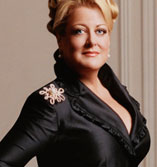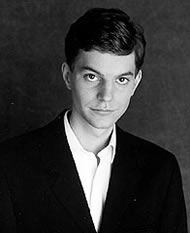Top 10 Live Performances
We hear so much good music every year, which makes this annual post difficult to compile. After consultation with my fellow reviewers, we offer this list of the ten best Washington-area concerts we heard in 2007 (a similar list from beyond the region tomorrow). It is pointless to try to rank them from best to least best, so they are listed in chronological order, with a memorable excerpt from our review. As always, your comments about the year in review are welcome. Deborah Voigt, Salome (Kennedy Center, January 18):
Deborah Voigt, Salome (Kennedy Center, January 18):
Behind the singers, Maestro Slatkin and the National Symphony Orchestra churned the lush score out with excellence, impressive brass work (scarcely a mistake and very expressive throughout). In combination with hearing the orchestra from the stage and not the pit, the Straussian orchestral genius was fully revealed and worth the price of admission alone. With the addition of Voigt and Held, this is a concert that ought not be missed by anyone whose pulse has a rhythm. (Jens F. Laurson)Kirov Opera: Lady Macbeth of Mtsensk (Kennedy Center, February 4):
Tenor Viktor Lutsiuk as Sergey visibly reveled in his part as that indefinably anti-heroic character (the only fitting description for this two-timing, double-crossing, misogynist, cunning, possibly loving – more likely exploiting element is: “scumbag”). A terrific actor of small gestures, he provided all the necessary drama to make one forget that this was not in fact a staged performance. Evgeny Akimov, in the relatively small role of Katerina’s indecisive, ineffectual husband Zinovy Borisovich Ismailov, made his strangulation a truly mourned event. His tenor sounded like the fullest of baritones, his voice rang above the orchestra with clarity and astounding ease. (Jens F. Laurson)
 Till Fellner (National Gallery of Art, February 11):
Till Fellner (National Gallery of Art, February 11):The first half concluded with J. S. Bach, the three-part inventions instead of the Well-Tempered Clavier. These pieces are often relegated to the status of etudes for advanced piano students, but Fellner rethought them as a cycle of character pieces, in a way that harmonized naturally with the way that Bach thought as a composer of encyclopedic collections. No. 5 was a drooping sarabande of beautiful languor, all achieved through tone and articulation -- the tempo never flagged. In no. 9, Fellner wove the tortured harmonic turns of the theme into a delicate web of complicated lace, and in no. 12 he produced an almost machine-like whirr of sound in the supporting voices. (Charles T. Downey)Leipzig Gewandhaus Orchestra (George Mason, March 3):
Chailly’s directorship in Leipzig is one of the happiest musical marriages that the east of Germany has had in the last half century. Don Juan, op. 20, was a fine example of that. Razor-sharp, acute, explosive, aggressive even, fine-tuned and in such unison that there was not a single blurred edge, not a smudged climax, nor a single unclean detail. Don Juan usually doesn’t sound this good. The force with which this 1889 tone poem was played was almost unnerving and tempted at least this listener to attempt to buckle his seatbelt. Concertmaster Frank Michael Erben’s solo moments were as exquisite as those torn and wild, ecstatic bits that were played to the hilt, the playful and light parts that came across perfectly dainty, the solemn gloom that was brooding and shuddered lowly with delight. (Jens F. Laurson)Osmo Vänskä with the National Symphony (Kennedy Center, March 7):
The opening string suite by Sibelius, Rakastava (The Lover) op.14 (originally a work for male choir) brought out the best in the NSO string section I have heard in a long, long time. Discipline, delicacy, detail, and coherence were evident everywhere; dynamic changes from pp to mf sounded like they came at the flick of a switch. The work itself is hushed and whispered here, a fragile dance there, silver-threaded, and with wistful pathos – audibly related to the Karelia Suite from around the same time. (Jens F. Laurson)
 Jenůfa (Washington National Opera, May 5):
Jenůfa (Washington National Opera, May 5):The lovely, smooth-voiced Patricia Racette captures both Jenůfa's innocent sweetness and her unmeasurable sorrow. Her voice has roundness and power in all registers and ranges from delectable simplicity, as in the heart-breaking setting of the Salve Regina, with quiet harp and glockenspiel, in Act II, to banshee's keen. She was matched in intensity, perhaps exceeded, by the other star of the evening, Catherine Malfitano, who reprised her lauded performance as the Kostelnička. In a severe black dress (costumes by Jon Morrell), she is a terrifying figure, making her unraveling at the end of Act II, where she has a guilt-ridden vision of "death staring me in the face," one of the most dramatic moments of the evening. (Charles T. Downey)Pierre-Laurent Aimard (La Maison Française, May 7)
This was the stunning effect of Aimard's juxtaposition of atonal and tonal selections, so that the end of one dovetailed perfectly with the next, often pivoting on the same note or chord. This was most striking in the third section, Intermezzo zodiacal, where Romantic sublimations of country dances like the Ländler, mostly by Schubert, alternated with movements from Karlheinz Stockhausen's Zodiac. (Was it a coincidence that this suite of pairings ended with the Virgo movements, which happens to be Aimard's astrological sign?) No matter how far toward the fluffy Romantic stereotype the selection went, even Liadov's A Musical Snuffbox and an excerpt from Tchaikovsky's Dance of the Sugar Plum Fairies, the pattern made Stockhausen seem only a step away. (Charles T. Downey)
 Christian Gerhaher and Gerold Huber (Vocal Arts Society, October 11):
Christian Gerhaher and Gerold Huber (Vocal Arts Society, October 11):The tall Huber, like Gerhaher in formal tails, sat hunched over the embassy's sonorous Bösendorfer, favoring the soft pedal to craft a delicate envelope of sound, like the Lotusblume opening only to the gentle moonlight, perfectly scaled to Gerhaher's voice. The softness of many of the songs honed one's ears, so that we were glad indeed when the performers paused while helicopters passed over the embassy. That sensitivity also made those moments when the full power of Gerhaher's high range and the boom of the Bösendorfer were unleashed even more impressive. My hair literally stood on end when Gerhaher roared at the end of Waldesgespräch and in Frühlingsnacht, both part of a complete performance of Liederkreis, op. 39. (Charles T. Downey)Andrew Manze and Richard Egarr (Clarice Smith Center, November 4):
As explained by the performers, Egarr sat at a Thomas and Barbara Wolf copy of a fortepiano by Johann Schantz, and Manze played on his historical instrument, a violin reconditioned to 18th-century standards. The result was an extraordinary glimpse into the musical past, in the intimate setting of the sold-out Gildenhorn Recital Hall, with the soft spectrum of these two instruments suited so well to one another and to the smaller hall. The program began with the F major sonata, K. 376, where the second movement (Andante) stood out for its well-chosen tempo and graceful ornamentation, as did the third for its force and folksy, earthy color. The E-flat major sonata, K. 481, featured an Allegretto movement a little, happily, on the plucky, poky side, at the end of which Egarr toyed with listeners who were tempted to clap before he began the capping fourth movement. (Charles T. Downey)
 Leipzig Quartet, Beethoven Anniversary (National Gallery of Art, December 16):
Leipzig Quartet, Beethoven Anniversary (National Gallery of Art, December 16):As a celebration of Beethoven's life, it is hard to imagine a better choice for a late-period quartet than the mysterious, quasi-liturgical op. 132 ("Heiliger Dankgesang," from 1825). Its third movement, a Lydian-mode song of thanksgiving for Beethoven's recovery from illness, became the psalm of solemn gratitude from the hearts of generations of Beethoven's devoted listeners. The Leipzig Quartet played a perfectly tuned, pure, and unified rendition. With almost no vibrato and careful attention to each note and line, its celestial ending left the quartet visibly exhausted. The bubbly, joyous second movement contained an enigmatic contrast with its own drone-based trio, a moment of Arcadian repose. (Charles T. Downey)HONORABLE MENTION:
- Susan Graham (Kennedy Center, January 26)
- Rape of Lucretia (Châteauville Foundation, April 14)
- Leila Josefowicz (Jewish Community Center of Greater Washington, May 13)
- Sasha Cooke (Young Concert Artists, September 30)
- Murray Perahia (Strathmore, October 28)
- Café Zimmermann (Library of Congress, November 3)
- Emmanuel Pahud and Eric Le Sage (Phillips Collection, November 7)
- Ben Heppner (Shriver Hall, December 2)





















































No comments:
Post a Comment